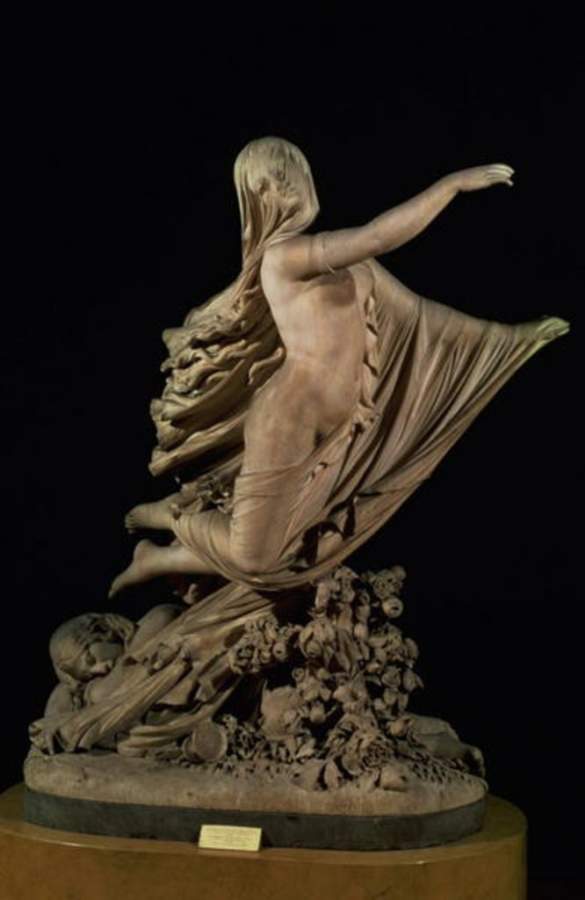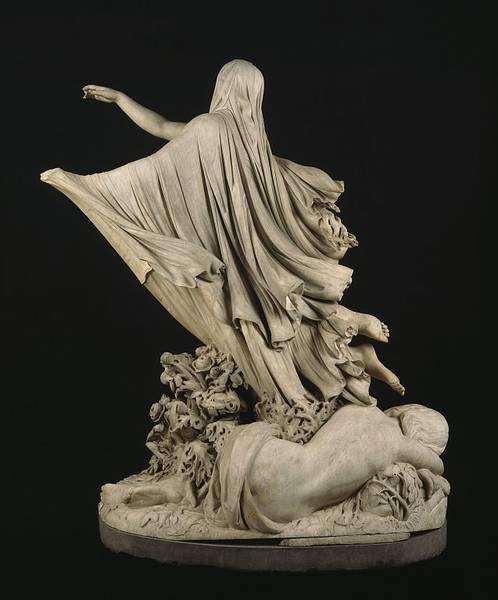Over at Affinity, voyager posted a thread of famous graves in Russia. [affinity] These are not my photos.
Thomas Sayers, Highgate Cemetary. The dog is perfect.

Edward “The Black Prince” – Canterbury. A childhood memory. I remember dad saying “they called him The Black Prince” and I thought that sounded very badass. It was around the time I was studying the crusades and I thought knights were pretty cool. I love the detail of the armor. Now, I see this differently: a monument to the vanity of another useless politician.

Steven Frank Marsh, Manor Park cemetary. Marsh was apparently a big fan of his BMW. The monument-makers did a pretty good job but they must have been shaking their heads.

Burian, a comedian. I have never seen this grave in person; I just love the expressiveness it conveys.

There is a stunning monument in the Victoria and Albert museum, by Raffaele Monti: So. Much. Carving.


There is a theme in some of these and I realized a few years ago what that theme is – what the underlying bit that attracts me. Can you spot it?
From Highgate:

Then there are the reclining ones – I love those:

It seems sad to leave these beautiful artworks outside to get eaten by acid rain. Remember acid rain?
Lawrence Matheson’s is my all-time favorite.


Could it be scantily clad hot women?
By the way, I like those too.
Ieva Skrebele@#1:
Could it be scantily clad hot women?
Yes, there’s that. It’s a specific thing about that.
In that case, I’m no longer so sure. I can think of various things that all of these sculptures have in common.
Well, there’s the poses. I don’t know how to call this type of poses. The kind that was used by artists and sculptors some centuries ago.
Then there’s also the fact that all of these sculptures are very well done and detailed. Artists who made them were really good.
Several of these sculptures have some fabric draped around the women.
All of these examples also share the same body type. Or should I say the same amount of body fat—unlike many modern supermodels, they don’t look like they have an eating disorder. Women depicted in older artworks also tend to have smaller breasts compared to what is perceived as ideal nowadays.
Then I’ll guess: Bare backs?
Long hair?
Clear waists and good hips?
I would guess coming back to life… hands coming out of a grave, a dog waiting patiently for someone, a “spirit” rising up from a dead person etc.
Lovely sculptures. I agree it’s a shame they are left out to disintegrate. But. Ancient Egyptians did kinda the same thing… having slaves work all the time creating woven cloth for dead people. Like, MILES of it. And in some cases it was woven FAR FINER than any of our modern machines can do. Pretty amazing.
kestrel @#6
I don’t think that the word “slave” is fitting here. Of course, slavery did exist in Ancient Egypt. It wasn’t very prevalent though. It’s tricky for historians to figure out exactly how many slaves they had in Egypt (words “slave” and “servant” were used interchangeably). It also depends on the period (the history of Ancient Egypt spans for several thousand years; of course they had some changes during such a long time period). However, we now know that in Ancient Egypt slavery wasn’t nearly as bad as in many other places. Ancient Egypt was a peasant-based economy. By the way, the pyramids were not built by any slaves. Let alone Jewish slaves. The Bible is a really bad source for historic facts.
Not a historian, but wouldn’t this be an argument for saying they’re all slaves? If they’re called the same name, aren’t they likely treated the same? If there are different rules for how to treat people, wouldn’t you call them by different terms? Isn’t that how it works in every other society?
“Hey, you can’t treat me like that, I’m X, not Y.”
If you can’t say that, then how are you not “Y”?
Here’s one from my home town, Melbourne.
https://melbournedaily.blogspot.com.au/2012/07/walter-lindrums-grave.html
Um, you have a fetish for unconscious women? In drapey clothes? That drive POS BMW convertibles?
And “Didi Gregorius makes Yankee fans uproarius!”
Roj Blake@#9:
Here’s one from my home town, Melbourne.
https://melbournedaily.blogspot.com.au/2012/07/walter-lindrums-grave.html
Nice!
I wonder if anyone has had a beer volcano gravestone… No, I am not going to search for it. Nor am I going to search for “tactical gravestone.”
Now I am thinking I shouldn’t have made the comment about “what I like” in the statues. But there’s truth in it. It requires a lengthier explanation than I want to give here; I’ll try to post about it eventually.
It’s the hands.
LykeX @#8
No, a servant in a (usually poor) person who works for a wealthier family. A slave is a person who is owned by somebody affluent. There’s a difference in their legal status even if both often do the same jobs. Thus when historians read Ancient Egyptian texts and see the word “slave” in them, they have to be careful in order to figure out whether the person mentioned in that text was, indeed, a slave.
Historically in different cultures there have been various social arrangements that resulted in some groups of people having limited freedom and shitty life conditions. It wouldn’t be reasonable for historians to widen the meaning of the word “slave” in order to encompass also all of these people.
Consider serfdom in Europe (High Middle Ages up until the mid-19th century; for example, in Imperial Russia serfdom was abolished only in the 1860s). There certainly was forced labor for serfs. More importantly, they were forbidden to leave the place where they were born. If they ran away and got caught, they were punished and sent back to their lord. I’d say that sounds pretty similar to slavery, yet there are good reasons why historians don’t use the word “slaves” when talking about these people.
Or the social status of women in many historical societies. Not allowed to own property, not allowed to get a divorce, not allowed to live where they want to, not allowed to marry whom they want. Besides, husbands were even legally allowed to beat their wives. That sounds a lot like slavery to me. Yet, once again, historians don’t use the word “slaves” when talking about women in these societies.
Sounds like nobody guessed it right.
When trying to guess what somebody else likes in an artwork people can either (1) say what they personally like about these artworks or (2) say what they are paying attention to.
For example, when looking at old artworks, I always keep noticing the shifting standards of beauty. For instance, if a woman who looked like the Aphrodite of Milos went to a modern modelling agency, she’d be told to get breast implants and lose some weight. Even more so for Rubens’ The Three Graces. They’d also be told to go to a tanning salon. I keep noticing this as a result of past experiences—when I was younger, people implied subtly and sometimes even not so subtly that I should strive to look like whatever happens to be the beauty standard of today. In my mind this always clashed with what I knew from my art history lessons. Thus I decided not to care about contemporary beauty standards—after all, looking more like the Greek goddess of beauty wasn’t that bad. Of course, that was years ago, before I decided that I don’t care about looking feminine in the first place.
kestrel, @ #6:
That’s a pretty remarkable claim. Do you have a source?
Indeed, but that wasn’t my point. My point is this: If a society has two classes of people, with different rights and circumstances, then why are they calling them by the same name? Has some important distinction been lost? Is it a translation issue, so the original actually makes a distinction? What’s going on?
It seems strange to me that you’d refer to two very different groups by the same term, especially when the distinction has very real consequences. The difference between a slave and a free person is so fundamental and important (for everyone involved), I don’t quite get how a society could function without some way to distinguish between them.
Is the term perhaps more correctly translated as “servant” and then a further distinction could be made between free servants and enslaved servants? I.e. it’s an umbrella term, used in situations where the important thing is what the person is doing (working for someone else), not their legal status?
I may be way overthinking this, but I just find it strange.
See:
http://www.touregypt.net/featurestories/slaves.htm
http://www.reshafim.org.il/ad/egypt/timelines/topics/slavery.htm
https://en.wikipedia.org/wiki/Slavery_in_ancient_Egypt
Yet this happens all the time in every language. When you open a dictionary to look up a word, how often you find that the word has more than only one meaning? Linguists call those homonyms or polysemes. Homonyms are words which have the same spelling and pronunciation, but different meanings. A distinction can be made between true homonyms, which are unrelated in origin, and polysemous homonyms, or polysemes, which have a shared origin. For example, bark (the sound of a dog) and bark (the skin of a tree).
By the way, it’s not like the English word slave has only one meaning. In BDSM community people use the word slave to refer to the submissive partner. Photographers use the word slave to refer to a flashlight that gets triggered upon detecting another light source. Then we also have wage slaves. And somebody can be a slave to fashion.
Also, you can also look up this Wikipedia article on serfs in Imperial Russia: https://en.wikipedia.org/wiki/Serfdom_in_Russia#Slaves_and_serfs. Pay attention to the “Slaves and serfs” sections and you will notice that the distinction between slaves and serfs was pretty blurry and sometimes intentionally made even muddier.
@Dunc: Here you go: https://www.metmuseum.org/pubs/bulletins/1/pdf/3257238.pdf.bannered.pdf You can find in the second paragraph a reference to cloth found woven with 200 ends per inch by 100 ends per inch. They also explain (in great detail) how this was achieved. They were weaving what’s called tabby: each thread goes over one and under one. That gives a lot of intersections per inch.
You can try an experiment: take a ruler and some thread. Wrap the thread around the ruler for one inch, as tight as you can get it. See if you can get 200 wraps. :-)
Thanks kestrel, that’s very interesting! I had no idea that ancient Egyptian linen was so fine… However, it’s not finer than many readily-available modern fabrics. (Oh, and technically “ends per inch” refers specifically to warp threads, so it can’t be a square measure. Fabric measurements are confusing.)
Too long ago I was in Paris for several weeks and my hosts asked if I would be interested in seeing Jim Morrison’s grave. So one fine Sunday we visited it. Not very impressive, but wondering back to the subway we passed a tomb with a man lying on his back. The bronze was all green save for his “junk” which was highly polished. Can’t remember his name, but he had a rep as quite the dandy and rubbing there was thought to transfer magic from rubee to rubber.
kestrel@#20:
They were weaving what’s called tabby: each thread goes over one and under one. That gives a lot of intersections per inch.
Is this the “pure shimmering samite” cloth of legend?
It sounds like they just went: throw people’s lives at it. Sort of reminds me of the way they made core memory back in the 60s. “let the women with small fingers do it.”
David@#22:
Not very impressive, but wondering back to the subway we passed a tomb with a man lying on his back. The bronze was all green save for his “junk” which was highly polished. Can’t remember his name, but he had a rep as quite the dandy and rubbing there was thought to transfer magic from rubee to rubber.
That could only be the tomb of Victor Noir, anarchist and dandy.
Marcus, an effigy is not “a monument to the vanity of another useless politician”, their purpose was different. Matt Easton has good videos about this, I will post them tomorrow on affinity.
@Dunc: yes, I’m a weaver and even teach it. So yes, I’m familiar with thread counts. Modern day counts use both warp AND weft, added together to get a higher count, and in some cases, take the fact that it’s a 2-ply thread to double that measure!! In real life you count the warp only. In the case of the Egyptian cloth we don’t know (as far as I’ve been able to find out) which was the weft and which the warp… after reading accounts of weavers striving to duplicate ancient cloth, I suspect that the cloth was warped at 100 epi and then they threw 200 epi in the weft. Still incredibly impressive. Tabby has so many intersections it’s tough to get the threads tight together, to get that many threads per inch. Using a different weave structure, where the threads can bundle themselves up together at the intersections, might give a higher count, but would not be the same.
Do you know of thread thin enough to be warped or used as weft at 200 epi while weaving tabby? I don’t. I am currently working with some super-fine silk, it’s the thinnest finest thread I’ve been able to find commercially, and it can’t be done with that.
Oh, and @Marcus: I think it shows how very much the Egyptians revered the dead, or thought about it death and dying. Putting that much effort into something like that is simply amazing. It might seem like a waste of time to me, but to them it was just really important.
“Woman tries to sleep during summer heatwave, gets tangled in sweaty bedsheets”
Oh, and the grave of Vlasta Burian, well known Czech comedian, originally had a metal bust. That bust was stolen by scrap metal scavengers and was replaced by the hands in 2007.
His life story is quite moving sad and disturbing.
kestrel@#27:
Oh, and @Marcus: I think it shows how very much the Egyptians revered the dead, or thought about it death and dying. Putting that much effort into something like that is simply amazing.
Or, alternatively, it shows how important rich and powerful Egyptian autocrats thought their deaths were, and they had armies of people (who otherwise wouldn’t have given a shit!) work very hard over their burial arrangements.
Have you notice that politicians still have huge overpriced funerals? It’s as though they can’t accept that they are finally equal with everyone else and want to have one final “fuck you!” splurge to show they were powerful, and vain, once.
Yeah, I sure have noticed. If rich people pay for their own overpriced funerals, I don’t care much. After all, paying for an extravagant and expensive funeral ceremony is not worse than all those other ways how rich people tend to spend their money. What pisses me off is when politicians use state money to pay for any ceremony that is supposed to demonstrate how powerful and vain the politician is (it’s not just funerals, politicians seem to love all sorts of expensive ceremonies).
kestrel, @ #26: I’m mostly familiar with shirting, which uses a somewhat different thread count system… The finest cloths I have are a 200/2 x 200/2 poplin (2-ply 200s warp and weft) and a 300/3 x 300/3 herringbone twill – but those thread counts aren’t threads per inch, they’re English cotton count (number of hanks per pound) and there’s no way to directly convert, since we don’t know how tight the weave is… They’re ludicrously fine though. I have seen tpi counts for Ventile, which is a very tight cotton Oxford (tight enough to be water-resistant without any treatment) and the finest grades of that get up to over 200 tpi on the weft – and these shirtings seem finer than that.
OK, looking at my 200/2 x 200/2 poplin under magnification, it looks like it’s “only” about 150 threads per inch each way… I stand corrected.
Marcus, @ #30: I don’t think you can force somebody to raise craftsmanship to the level of art. To take a craft and develop its techniques such an extent seems to me to require genuine enthusiasm and dedication. You can’t produce quality in a sweatshop.
Ieva Skrebele@#31:
If rich people pay for their own overpriced funerals, I don’t care much.
…
What pisses me off is when politicians use state money to pay for any ceremony that is supposed to demonstrate how powerful and vain the politician is
The rich person either inherited their wealth (so it’s basically a demonstration of their unfairness and luck) or got it usually by walking on the backs of “their” workers. I don’t see the wealthy as a distinct class from the political class, anymore. They’re all the same people.
OK, that’s reasonable. And I just realized the inherent bias in my original statement.
The thing is, for me it feels different. In the first case we have taxpayers’ money being used for a private display of power. I cannot avoid paying taxes, so it pisses me off when politicians force me to pay for their private parties and celebrations. In the second example we have a rich person using the money earned by some private business. Can I avoid giving my money to rich assholes’ companies? Occasionally, I can. For example, I can buy my food in the farmers’ market and not from big companies. But more often than not I actually have no choice, for example, I cannot avoid giving my money to either Apple or Microsoft. So why does it even feel different? Yet, somehow, it does.
Another reason for me feeling different about both of these scenarios (tax payer funded celebration vs. privately funded celebration) is the ease with which I can imagine other better ways how this money could be spent. It’s simple for me to imagine better ways how to spend taxpayer money—healthcare, education, etc. It’s not so simple to imagine better ways how billionaires could spend their money. Why should I care whether a billionaire pays for opulent mansions, luxury cars or expensive celebrations? It makes no difference for me. When thinking about this, it takes me an extra step to think further about the fact that the billionaire could have instead not earned this money at all and this money could have been better spent on salaries of some impoverished workers.
Ieva, often there is less distinction between taxpayer money and billionaire money. Some have lucrative contracts with the state and make money quite literally out of your taxes. Many get tax breaks and other expensive perks on your dime, ostensibly for “job creation” and other trickle-down bullshit. A lot get away with worker exploitation and environmental destruction and worse, because the state lets them. I am in agreement with Marcus that the distinction is not very relevant. It may not be your taxes, but it could very well be your grandparents’, or your grandchildren’s.
cvoinescu @#37
You are talking about the U.S.A. It’s a bit different where I live. It’s not even possible to translate “trickle-down economics” into my native language, there’s no term for that. Here voters just don’t buy the idea that giving more money to the rich will somehow create jobs. And tax cuts for the wealthy just don’t exist here. We even have some halfhearted attempts to give tax cuts for the poor. People with extremely small salaries have a bit lower income tax rate. Real estate tax is also larger for the rich. Your real estate tax rate depends on how many square meters per person you have in your house/apartment. If you live alone in a big house, the tax rate is higher. I perceive all this as just halfhearted attempts, because the difference in tax rates isn’t significant. But, oh well, at least here the rich don’t dare blatantly giving themselves some tax cuts.
That’s corruption, and it is illegal here. Of course, just because something is illegal doesn’t mean it never happens. It just means politicians have gotten really subtle and sneaky about it. For example, some years ago we had an elected politician who passed a law about subsidies for renewable energy. It just so happened that this politician also owned a company that dealt with wind turbines. What a coincidence.
Let’s assume that some city needs to build a new road or a new school or hospital or whatever. The city major cannot just give the contract to his golf buddy who happens to own a construction company. If he tried that, he’d risk jail time. The law says that whenever the state wants to hire some company to do something, they need to announce a competition where any business can submit their price proposal for the job. The state is obliged to choose the cheapest price proposal. How can politicians cheat the system? Easy, just give your golf buddy some insider information about the project. You may give your buddy all the info sooner and publicly announce the competition in the last moment so that it’s harder for competitors to submit their price proposals. You can also simply withhold some information in the public contest so that competitors submit higher prices than necessary. But politicians are still forced to be subtle with this. If the profits become too lucrative, there’s a higher risk that people will notice and the result may be some jail time.
In my native language these practices are called politbizness. It’s a compound word that’s made by combining words “politics” and “business.”
Environmental protection laws are actually pretty good here. Sure, there’s plenty of room for improvement, but it’s not that bad.
Worker exploitation (giving them very small wages) is pretty much the main way how people get rich here.
The bottom line: sure, some businessmen figure out ways how to steal tax money also where I live. But I don’t have the impression that this is prevalent enough for me to perceive private profits and state tax money as one and the same.
@Dunc, #33: Wow, that’s very good! I will include that information next time I teach, because I did not know we could get that close. I’m dying to know where you get your thread. I’m always on the look-out for tiny amounts of super-fine thread in natural colors (browns, greys, whites, blacks) and the silk I’m currently working with is the tiniest I’ve ever been able to find. I’d be thrilled to find some even finer.
@Dunc – hm, I am fascinated by the knowledge-set you bring to the table.
Some of the shirting you describe made me drool a little bit. My Saudi thawb may be made of the kind of cotton you describe.
By the way, and you probably already know this: I did not realize that herringbone weave is not ancient. It was not invented, say, around the time when jesus would have been wrapped in a herringbone weave linen shroud. That has implications!
Ieva Skrebele@#38:
The city major cannot just give the contract to his golf buddy who happens to own a construction company. If he tried that, he’d risk jail time
What!!?? Then how does anything get done?!
Joking aside: Donald Trump used to brag about how he stepped in on a project (I think it was some construction at Madison Sq Garden) that was lagging, and made deals and pushed and got things done. That’s New Yorker code for corruption – bypassing the bidding process and simply tossing the work to your golf buddy. New Yorkers knew all along what Trump is; I suspect you would have trouble finding a New Yorker with a brain who didn’t expect the kind of corruption Trump has been fostering in Washington. It’s not “draining the swamp” it’s “one mob taking over new territory from another mob.”
kestrel, @ #39: Well, the 300/3 herringbone twill was an eBay purchase from a guy who has excellent contacts in the trade – he doesn’t say which mills the odds and ends he sells come from, and I don’t ask. People can be funny about that sort of thing… The 200/2 poplin was a limited edition from a specialist English shirting supplier called Acorn Fabrics. The finest they carry in their regular range is 170/2… I don’t know if they’ll sell their yarn, but you can always ask.
The finest yarn I’ve ever heard of must therefore be the warp yarn in L34 Ventile, which is specc’d at 95 threads per centimetre (which works out as an incredible 241 ends per inch).
Marcus, @ #40: I’m just trying to keep up. You have a pretty good commentariat here. ;)
I’m not 100% sure about the origins of herringbone… It’s hardly the biggest problem the Shroud of Turin has though.
Wait a minute. Trump publicly bragged about engaging in corruption. And he got away with it. There was no investigation, no criminal charges. He just got away with it. Are there no laws that ban corruption in USA?
What is the underlying theme?